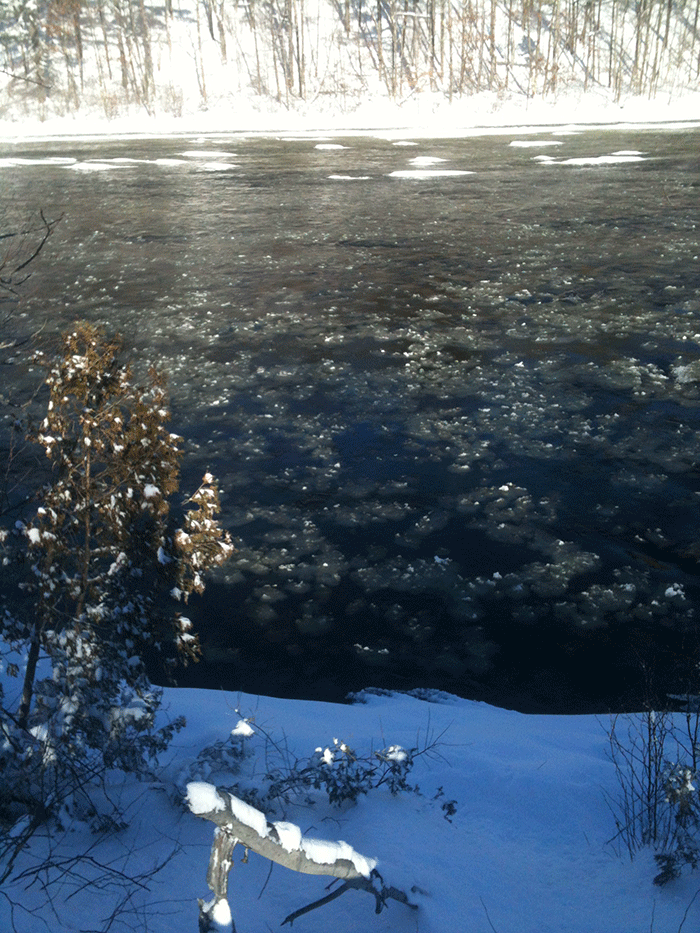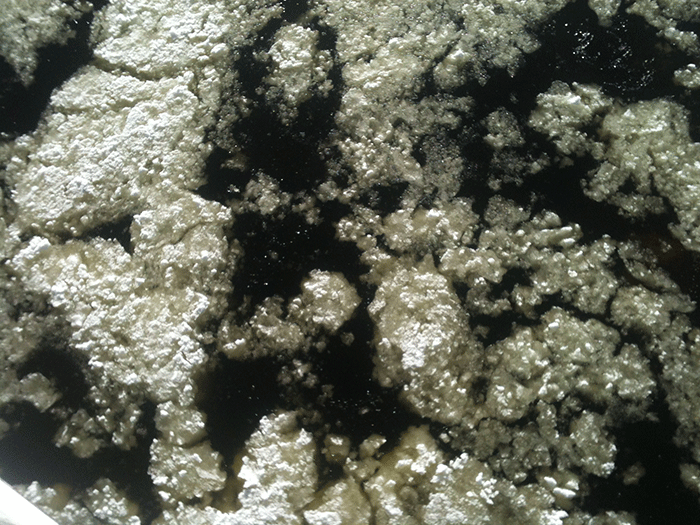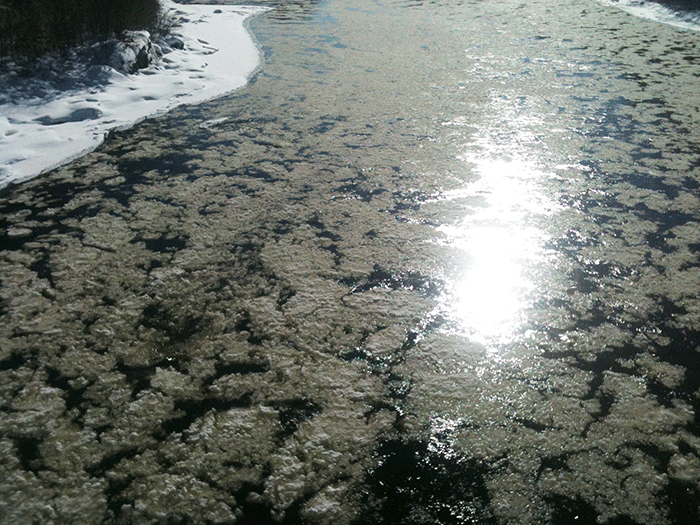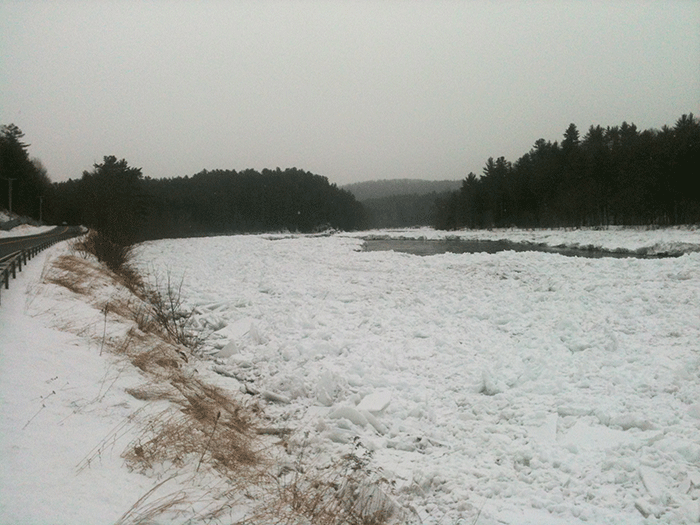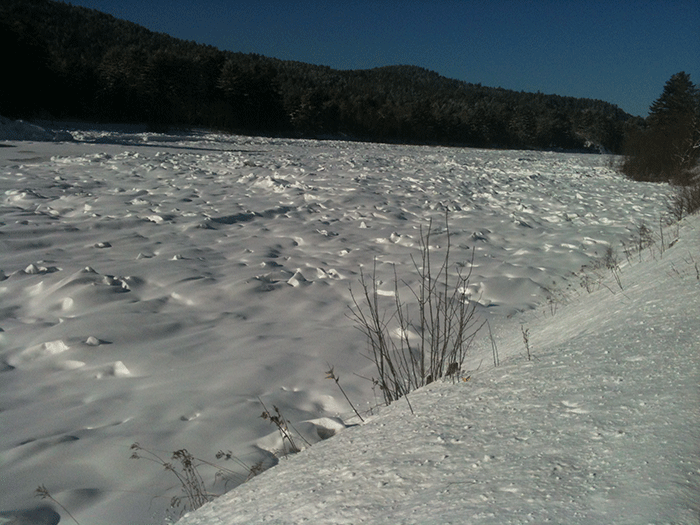The bitter cold temperatures across the Adirondacks in the first few days of 2014 have been a boon for the manufacture of frazil ice in the Hudson River, from the Hudson Gorge to The Glen, and hanging dams of ice all through the ice meadows below The Glen. Evelyn Greene, a PROTECT Board member and naturalist in North Creek, has tracked frazil ice over the years on the Hudson.
Here’s the process for the development of massive amounts of ice throughout the ice fields in the Hudson in Thurman and Warrensburg.
Below is an article Evelyn wrote years back about how frazil ice forms, which build the massive ice blocks that dam up the Hudson at the ice meadows.
Frazil ice is the river ice that looks a lot like slush as it floats down the river by the ton on cold days when it is not snowing. Frazil can start forming when the air temperature is about 25 F if the water is already at 32, but the below 0 F days were great for creating massive amounts.
Frazil is most noticeable between Warrensburg and The Glen because roads go along the Hudson River on both sides for much of the way. Some years the brilliant white ice has filled the river almost all the way to North River. The tiny disk-shaped frazil ice crystals form in rocky, turbulent rivers where the cold air above the river gets mixed enough into the water to keep the water slightly below freezing (super-cooled) despite the heat which is released whenever a crystal forms and grows.
Projections, or “dendrites,” try to grow from the frazil disks but break off in rough water (in the ocean and big lakes, too), creating billions more nuclei for frazil crystals to grow on. (There has to be a nucleus for an ice crystal to start growing, and in water that pretty much has to be ice, which can come from bubbles bursting and the droplets freezing and falling into the water.) The whole river, top to bottom, will then have frazil crystals tumbling in the water, hitting the bottom.
Oldtimer Adirondackers around here call frazil “anchor ice,” which is the term ice engineers use for ice that collects underwater, clinging to rocks in masses on the river bottom in shallow areas and on objects such as water intakes for turbines, and in our case in North Creek, for making snow. Engineers here designed a heated intake to prevent frazil from sticking to the grid and stopping the water. One-hundred years ago, seamstresses in the shirt factory in Warrensburg would have a day off when anchor ice on the Schroon River shut down the water turbines necessary to power their sewing machines.
So, what makes the Hudson fill up with frazil (and are not just covered by solid ice) when most other rivers and streams in the Adirondacks do not? Hanging dams. Ice jams are made mostly of big chunks of solid ice during warm weather rain storms when the river and tributaries are still full of ice and when the flooded river meets a constriction like a bridge.
Hanging dams, an engineering term, form in very cold weather after a complete cover of frazil bridges the river. The ice cover usually starts in a relatively calm area of the river and often where there is a big curve, from what I have observed. When the surface water carrying the frazil is moving over 2 miles an hour, the water ducks under the cover carrying the frazil with it. Underneath the cover, the frazil floats up wherever the water slows down, plating out on the underside of the cover, then thickening downwards in huge masses of frazil.
These hanging dams eventually slow the current down to where it starts backing up, saturating the bright white frazil cover and loosening all the crystals which may have frozen together. The entire frazil surface gets raised up by the rising water and floats the cover above the sloping shores. You can tell when the river is backing up when you see greenish water amongst the frazil cover, pools form next to the shore, and you hear crackling from frozen parts of the pools.
When some of the hanging dams finally break, as they have to because the river flow is inexorable and forces its way downriver, the water level falls quickly and the whole cover of frazil lowers, settling onto the sloping shores on the edges of the river.
This process can happen a few times at the beginning of the winter, but eventually the cover stabilizes at a level slightly above the river, allowing the water to flow unhampered by hanging dams on its way to the ocean, and leaving frazil deposits 10 feet thick on shore after the main current washes away the cover over it. These 10-foot-high deposits can last into mid-April at the Warrensburg park next to Cronin’s Golf Course.
Understand it all? I don’t either, but after 25 years of watching and studying I’m getting there.

